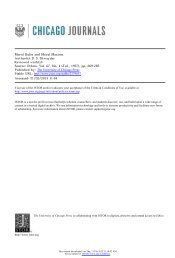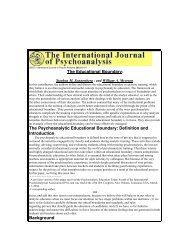A Companion to Linear B - The University of Texas at Austin
A Companion to Linear B - The University of Texas at Austin
A Companion to Linear B - The University of Texas at Austin
You also want an ePaper? Increase the reach of your titles
YUMPU automatically turns print PDFs into web optimized ePapers that Google loves.
§12.2 SCRIBES, SCRIBAL HANDS AND PALAEOGRAPHY 95<br />
§12.2. THE WORLD OF THE MYCENAEAN SCRIBES<br />
In Part 1 (§12.1), we have discussed in detail how palaeographical research<br />
on the <strong>Linear</strong> B tablets developed from 1900 <strong>to</strong> the present. We have seen how<br />
paying <strong>at</strong>tention <strong>to</strong> the handwriting on the <strong>Linear</strong> B tablets, nodules, labels and<br />
stirrup jars and <strong>to</strong> everything connected with the use <strong>of</strong> inscribed m<strong>at</strong>erials<br />
helps us <strong>to</strong> understand better the his<strong>to</strong>rical meaning <strong>of</strong> the texts written in <strong>Linear</strong><br />
B. In so doing, we have looked <strong>at</strong> how scribes are identified and wh<strong>at</strong> we<br />
know about their individual peculiarities as users <strong>of</strong> writing within Mycenaean<br />
pal<strong>at</strong>ial culture ca 1400-1200 BC. 124<br />
In this part, I shall briefly reconstruct some aspects <strong>of</strong> wh<strong>at</strong> we might call<br />
the world <strong>of</strong> the scribes. I shall try <strong>to</strong> use informed imagin<strong>at</strong>ion.<br />
John Chadwick, in discussing the genius <strong>of</strong> Michael Ventris, said this <strong>of</strong><br />
him: 125 ‘He had a keen appreci<strong>at</strong>ion <strong>of</strong> the realities <strong>of</strong> a situ<strong>at</strong>ion; the Mycenaeans<br />
were <strong>to</strong> him no vague abstractions, but living people whose thoughts he could<br />
penetr<strong>at</strong>e.’ We need <strong>to</strong> consider the ‘realities <strong>of</strong> the situ<strong>at</strong>ion’ for tablet-writers<br />
in the Mycenaean pal<strong>at</strong>ial period in the same way.<br />
Here we should imagine wh<strong>at</strong> it was like in the 14th and 13th centuries BC<br />
<strong>to</strong> have the skill <strong>of</strong> writing. How would someone acquire such a skill? Why<br />
would he want <strong>to</strong> learn the <strong>Linear</strong> B script? Wh<strong>at</strong> use did he anticip<strong>at</strong>e making<br />
<strong>of</strong> writing? If he was going <strong>to</strong> devote considerable time and energy <strong>to</strong> learning<br />
how <strong>to</strong> write and <strong>to</strong> use the art <strong>of</strong> writing, wh<strong>at</strong> st<strong>at</strong>us, benefits and responsibilities<br />
did he think he would derive as a liter<strong>at</strong>e person? If and when he<br />
worked within a liter<strong>at</strong>e bureaucr<strong>at</strong>ic system in a pal<strong>at</strong>ial terri<strong>to</strong>ry, wh<strong>at</strong> kinds<br />
<strong>of</strong> work would he be doing on a daily basis, and how might th<strong>at</strong> work change<br />
over time, as he became more experienced and trustworthy as a tablet-writer<br />
and record-keeper?<br />
Was he ever a she, as is the case occasionally in the ancient Near and Middle<br />
East? 126 How did the individuals and organiz<strong>at</strong>ions who held the gre<strong>at</strong>est<br />
power in the pal<strong>at</strong>ial terri<strong>to</strong>ries (e.g., the king or wanaks; 127 the military leader<br />
124 For the d<strong>at</strong>es <strong>of</strong> different groups <strong>of</strong> tablets <strong>at</strong> sites on Crete and the Greek mainland, see<br />
DRIESSEN 2008, especially 75-77.<br />
125 CHADWICK 1967b, 4.<br />
126 PEARCE 1995, 2266, discusses a few notable exceptions <strong>to</strong> the prevailing p<strong>at</strong>tern in the ancient<br />
Near and Middle East th<strong>at</strong> the pr<strong>of</strong>ession <strong>of</strong> ‘tablet-writers’ was a male pr<strong>of</strong>ession. <strong>The</strong>se<br />
exceptions include a daughter <strong>of</strong> Sargon <strong>of</strong> Akkad, who, inter alia, wrote a lengthy poem<br />
praising the goddess Inanna. Women scribes, some <strong>of</strong> whom were themselves the daughters<br />
<strong>of</strong> scribes, are <strong>at</strong>tested during the Old Babylonian period <strong>at</strong> Mari and Sippar. At Mari, nine <strong>of</strong><br />
ten women scribes are recorded as receiving r<strong>at</strong>ions, and their portions are ‘small enough <strong>to</strong><br />
suggest th<strong>at</strong>, although liter<strong>at</strong>e, they were held in low regard and were slaves <strong>of</strong> the harem.’<br />
127 PALAIMA 2006.

















